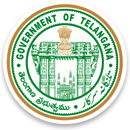
- Telangana State Statistical Year Book


The Telangana State was carved-out from the erstwhile Andhra Pradesh and came into existence with effect from 2nd June, 2014. The State emerged as 29th and the youngest State in the Indian Union with a geographical area of 1,12,077 Sq. Kms., (After accounting for the transferred 327 villages from the erstwhile Khammam district to Andhra Pradesh) and is the twelfth largest State in terms of both area and the size of the population in the country. Telangana is located on the Deccan Plateau and lies in the Southern region of India. The State is strategically located in the central stretch of the eastern seaboard of Indian Peninsula. The State is bordered by the States of Maharashtra to the North and North-West and Chhattisgarh to the North, Karnataka to the West, and Andhra Pradesh to the South, East and North- East.
As per the 2011 Census, total population of the State is about 3.50 crore. The overall population growth rate during 2001 to 2011 is about 13.58 percent as against the national growth of 17.70 percent. Majority of the population in the State reside in rural areas and mainly depend on agriculture for their livelihood. However, population in urban areas has been witnessing a significant increase in recent years, resulting in Telangana becoming one of the fastest urbanizing States in the country. The major cities in Telangana State include Hyderabad, Warangal, Mahabubnagar, Karimnagar, Nizamabad, and Khammam.
Telangana State is divided into four agro-climatic zones based on the geographical characteristics such as rainfall, nature of soils, climate etc., viz., (i) Northern Telangana Zone (ii) Central Telangana Zone, (iii) Southern Telangana Zone and (iv) High Altitude and Tribal Zone. The Climate of the State is predominantly hot and dry.
The annual normal rainfall of the State is around 905.3 mm. Important soils include red sandy loams, red loams with clay base along with very small patches of alluvial soils. The maximum and minimum temperatures during south west monsoon ranges between 13°C - 27°C and 29°C - 34°C, respectively. Horticulture has become a promising source of income for farmers due to favourable climatic conditions. Presently, the State is the major contributor in horticultural production, such as mango, mosambi, red-chilli, turmeric, marigold and vegetables. Telangana is rich in livestock resources, especially cattle and sheep population. Animal Husbandry provides an additional income and employment to the farmers, especially during droughts.
Telangana has diversified its industrial base, from high-tech nano-technology, biotechnology and pharmaceuticals to traditional textiles, leather, minerals, and food processing. The State is one the major exporter of Information Technology (IT) services in the country. Hyderabad has become a premier global destination for IT and ITeS.
Apart from Hyderabad, cities such as Warangal, Karimnagar and Nizamabad are emerging as Tier-2 for IT and IT-based industries. The State has become an important tourist destination for both domestic and international tourists. Hyderabad has gained a brand of its-own and became a premier medical, business and MICE tourism destination in the world.